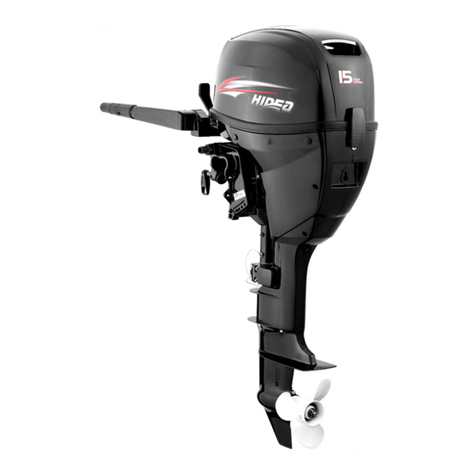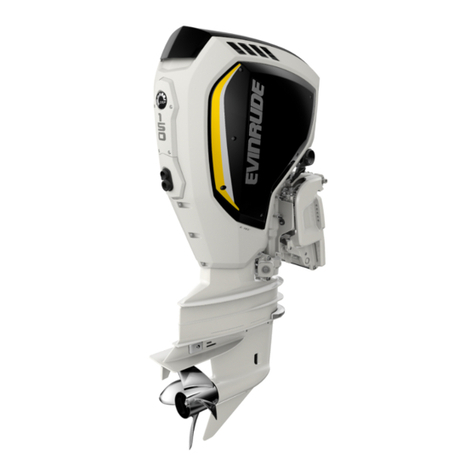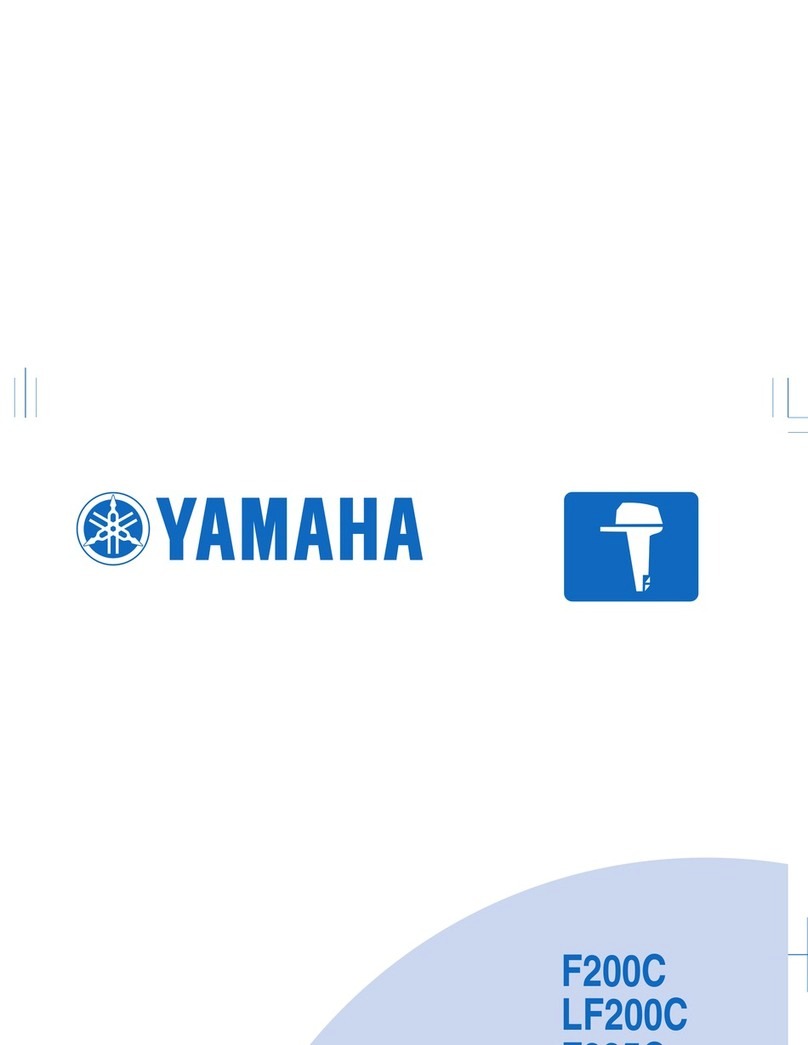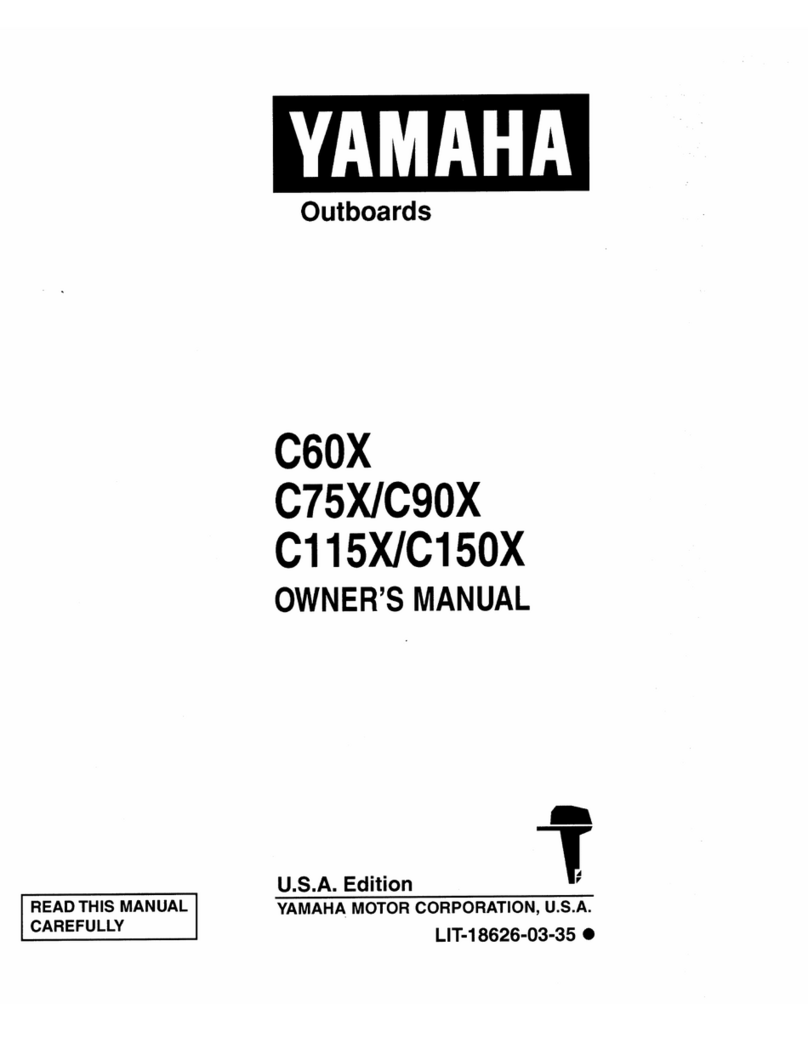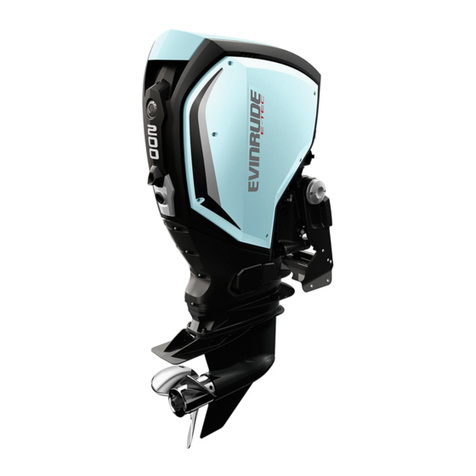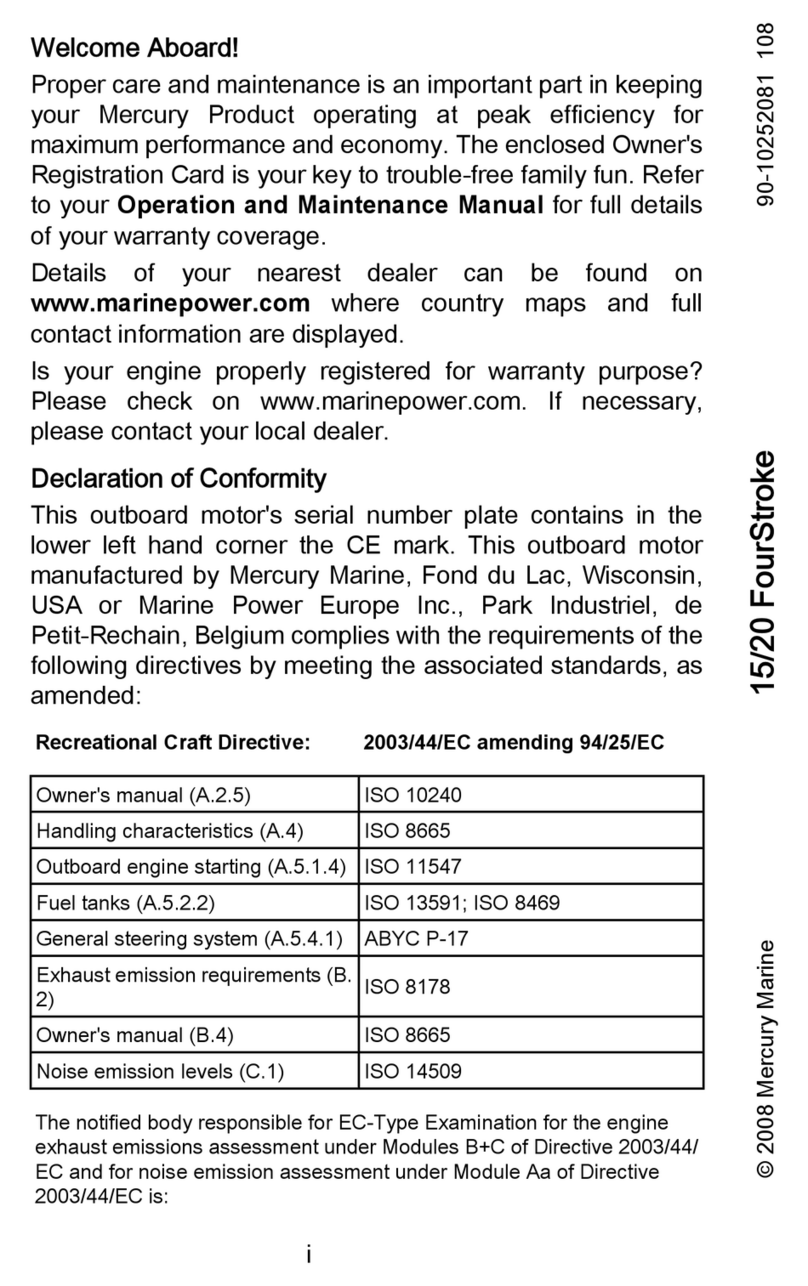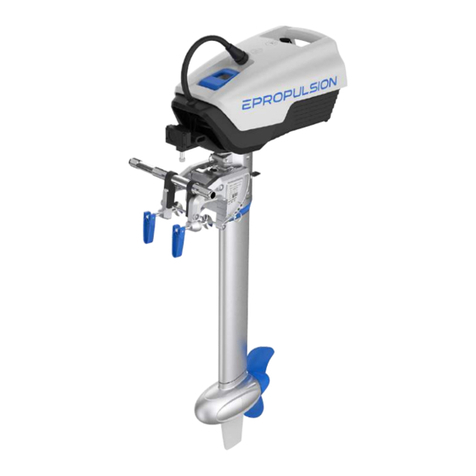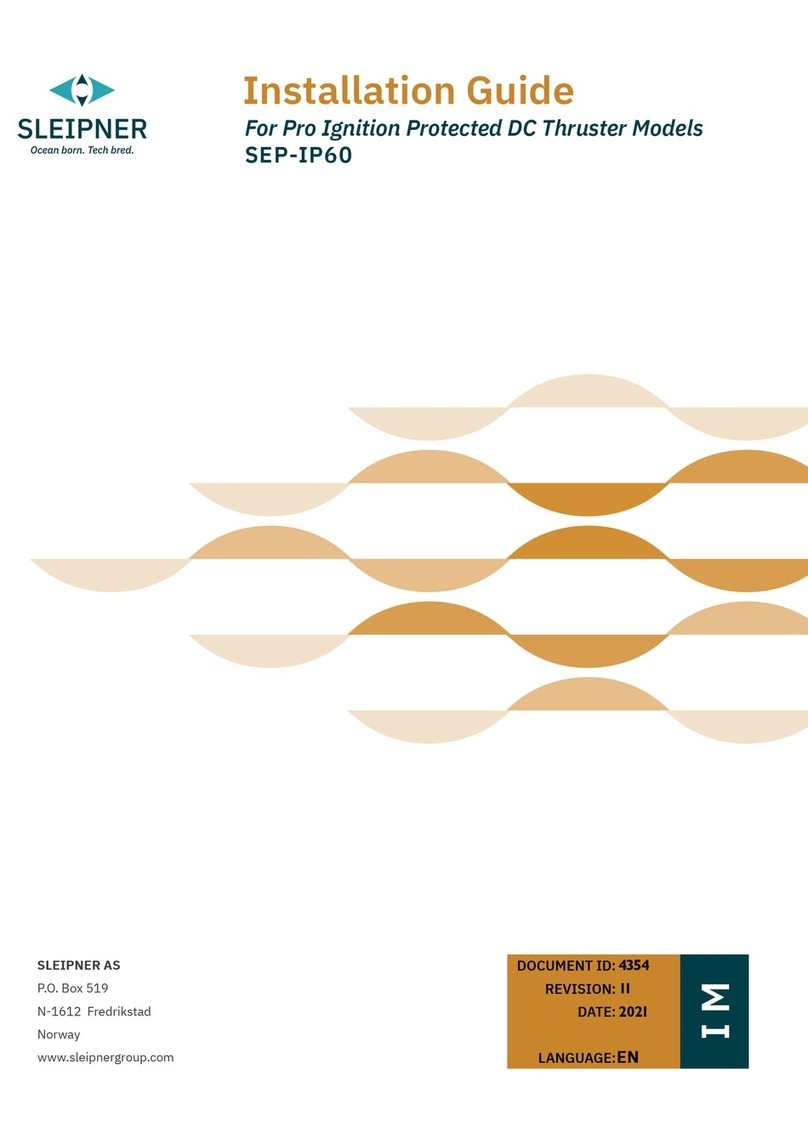Hidea F60 User manual

·F60
·F40
Owner’s Manual
Outboard Motor Series

Read this manual carefully before operating this outboard motor.
Keep
this
manualonboard in a waterproof bag when boating.This
manual
should stay
with theoutboardmotorif it is sold.

Important manual information
To the owner there is any question concerning this manu-
al, please consult your Hidea dealer.
Thank you for selecting a Hidea outboard
motor. This Owner’s Manual contains infor-
mation needed for proper operation, mainte-
nance and care. A thorough understanding of
these simple instructions will help you ob- tain
maximum enjoyment from your new Hidea. If
you have any question about the operation or
maintenance of your outboard motor, please
consult a Hidea dealer.
In this Owner’s Manual particularly important
information is distinguished in the following
ways.
This is the safety alert symbol. It is used to
alert you to potential personal injury hazards.
Obey all safety messages that follow this
symbol to avoid possible injury or death.
WARNING
A WARNING indicates a hazardous situa-
tion which, if not avoided, could result in
death or serious injury.
TIP:
The F40, F60 and the standard accessories
are used as a base for the explanations and
illus- trations in this manual. Therefore some
items may not apply to every model.
NOTICE
A NOTICE indicates special precautions
that must be taken to avoid damage to the
outboard motor or other property.
TIP:
A TIP provides key information to make pro-
cedures easier or clearer.
Hidea continually seeks advancements in
product design and quality. Therefore, while
this manual contains the most current prod-
uct information available at the time of print-
ing, there may be minor discrepancies
between your machine and this manual. If

Table of contents
Safety information……………………….1
Outboard motor safety.......................1
Propeller ...........................................1
Rotating parts ....................................1
Hot parts...........................................1
Electric shock.....................................1
Power trim and tilt .............................1
Engine shut-off cord (lanyard) ..............1
Gasoline............................................1
Gasoline exposure and spills ................2
Carbon monoxide...............................2
Modifications.....................................2
Boating safety ...................................2
Alcohol and drugs...............................2
Personal flotation devices ....................2
Overloading.......................................2
Avoid collisions ..................................3
Weather............................................3
Accident reporting..............................3
Passenger training ..............................3
Boating safety publications ..................3
Laws and regulations ..........................3
Basic boating rules (Rules of the road) .4
Steering and sailing rules and sound
signals...............................................4
Other special situations.......................5
General information……………………..8
Identification numbers record..............8
Outboard motor serial number ............8
Key number .......................................8
Read manuals and labels .....................9
Warning labels ...................................9
Specifications and
Requirements …………………………….12
Specifications...................................12
Battery requirements........................14
Specifications of Battery ................... 14
Remote control requirements............ 14
Mounting battery............................. 14
Multiple batteries ............................ 14
Propeller selection........................... 15
Start-in-gear protection....................15
Engine oil requirements ...................16
Fuel requirements ...........................16
Gasoline .........................................16
Ring Free Fuel Additive ..................... 17
Anti-fouling paint .............................17
Motor disposal requirements ............ 17
Emergency equipment...................... 17
Emission control information............. 17
North American models.................... 17
Star labels .......................................18
Components……………………………….20
Components diagram....................... 20
Fuel tank......................................... 21
Fuel joint ........................................21
Fuel gauge ......................................22
Fuel tank cap ...................................22
Air vent screw..................................22
Remote control box.......................... 22
Remote control lever........................ 22
Neutral interlock trigger.................... 22
Neutral throttle lever........................22
Tiller handle....................................23
Gear shift lever ................................ 23
Throttle grip .................................... 23
Throttle indicator .............................23
Throttle friction adjuster ................... 24
Engine shut-off cord (lanyard) and clip 24
Engine stop button........................... 25
Main switch..................................... 25
Steering friction adjuster................... 25

Table of contents
Power trim and tilt switch on remote
control or tiller handle ......................26
Power trim and tilt switch
on bottom cowling………………………..…26
Variable trolling RPM switches ...........27
Trim tab with anode .........................28
Tilt support lever for power trim and tilt
model .............................................28
Cowling lock lever(s) (turn type).........29
Fuel filter/Water separator ................29
Flushing device ................................29
Instruments and indicators…………31
Digital tachometer............................31
Hour meter......................................31
Tachometer .....................................31
Trim meter ......................................31
Low oil pressure-alert indicator..........32
Digital speedometer.........................32
Speedometer...................................32
Fuel gauge.......................................33
Trip meter / Clock / Voltmeter............33
Fuel level-alert indicator....................34
Low battery voltage-alert indicator .....34
indicator…………………………………………….34
Analog tachometer...........................34
Low oil pressure-alert indicator ..........34
Overheat-alert indicator ....................35
Analog trim meter ............................35
Command link multifunction meters...35
Command link multifunction..............36
Start-up checks ................................37
Adjusting trolling speed.....................37
Low oil pressure-alert .......................37
Overheat alert..................................38
Water separator alert........................38
Low battery voltage-alert...................39
Engine trouble alert..........................39
Command link multifunction speed &
fuel meters ....................................... 40
Command link multifunction
speedometers ................................... 41
Command link multifunction
fuel management meters..................41
Engine control system…………………43
Alert system ....................................43
Overheat alert ................................. 43
Low oil pressure alert ....................... 43
Installation………………………………… 45
Installation ...................................... 45
Mounting the outboard motor...........45
Operation…………………………………..47
First-time operation ......................... 47
Fill engine oil……………………………..…….…47
Breaking in engine............................ 47
Getting to know your boat ................ 47
Checks before starting engine ........... 47
Fuel level ........................................ 47
Remove the top cowling ...................48
Fuel system .....................................48
Controls..........................................48
Engine shut-off cord (lanyard)............49
Engine oil........................................49
Engine ............................................50
Flushing device ................................50
Install top cowling ............................50
Power trim and tilt system ................ 51
Battery ...........................................51
Filling fuel....................................... 51
Operating engine............................. 52
Sending fuel (portable tank) ..............53
Starting engine ................................ 54
Checks after starting engine .............. 56
Shifting ........................................... 57
Warming up engine.......................... 57

Table of contents
Manual start and electric start............57
models............................................57
Checks after engine warm up.............57
Shifting ...........................................57
Stop switches...................................57
Stopping boat ..................................58
Stopping engine ...............................59
Procedure .......................................59
Trolling............................................59
Adjusting trolling speed.....................59
Trimming outboard motor .................60
Adjusting trim angle (Power trim and tilt)
......................................................61
Adjusting boat trim...........................62
Bow Up ...........................................62
Bow Down.......................................62
Tilting up and down..........................62
Procedure for tilting up (power trim and
tilt models)......................................63
Procedure for tilting down (power trim
and tilt models)................................64
Shallow water ..................................65
Power trim and tilt models ................65
Cruising in other conditions ...............66
Cruising in salt water ........................66
Maintenance………………………………67
Transporting and storing
outboard motor...............................67
Storing outboard motor.....................67
Procedure .......................................68
Lubrication ......................................69
Cleaning and anticorrosion measures..69
Flushing power unit ..........................69
Cleaning the outboard motor.............71
Checking painted surface of outboard
motor .............................................71
Periodic maintenance.......................71
Replacement parts ...........................71
Maintenance interval guidelines ........ 72
Maintenance chart 1 ........................ 73
Maintenance chart 2 ........................ 75
Greasing ......................................... 76
Cleaning and adjusting spark plug ...... 76
Inspecting idle speed ........................77
Changing engine oil.......................... 77
Inspecting wiring and connectors .......79
Checking propeller ........................... 79
Removing propeller..........................80
Spline models .................................. 80
Installing propeller ...........................80
Spline models .................................. 80
Changing gear oil ............................. 81
Cleaning fuel tank ............................82
Inspecting and replacing anode(s)......83
Checking battery (for electric start
models) ............................................83
Using a single battery ....................... 84
Using an accessory battery ................ 84
Connecting the battery ..................... 84
Disconnecting the battery ................. 85
Trouble Recovery………………………..86
Troubleshooting...............................86
Replacing fuse ................................. 89
Temporary action in emergency ......... 89
Impact damage................................ 89
Power trim and tilt will not operate.... 90
Water separator-alert indicator
blinks
while cruising .................................. 91
Starter will not operate..................... 93
Emergency starting engine ................94
Treatment of submerged motor .........94

Safety information
1
Outboard motor safety
Observe these precautions at all times.
Propeller
People can be injured or killed if they come in
contact with the propeller. The propeller can
keep moving even when the motor is in
neutral, and sharp edges of the propeller can
cut even when stationary.
●
Stop the engine when a person is in
the water near you.
●
Keep people out of reach of the
propeller, even when the engine is off.
Rotating parts
Hands, feet, hair, jewelry, clothing, PFD
straps, etc. can become entangled with inter-
nal rotating parts of the engine, resulting in
serious injury or death.
Keep the top cowling in place whenever pos-
sible. Do not remove or replace the cowling
with the engine running.
Only operate the engine with the cowling re-
moved according to the specific instructions in
the manual. Keep hands, feet, hair, jewel- ry,
clothing, PFD straps, etc. away from any
exposed moving parts.
Hot parts
During and after operation, engine parts are
hot enough to cause burns. Avoid touching
any parts under the top cowling until the en-
gine has cooled.
Electric shock
Do not touch any electrical parts while start-
ing or operating the engine. They can cause
shock or electrocution.
Power trim and tilt
Body parts can be crushed between the mo-
tor and the clamp bracket when the motor is
trimmed or tilted. Keep body parts out of this
area at all times. Be sure no one is in this
area before operating the power trim and tilt
mechanism.
The power trim and tilt switches operate
even when the main switch is off. Keep peo-
ple be away from the switches whenever
working around the motor.
Never get under the lower unit while it is tilt-
ed, even when the tilt support lever is locked.
Severe injury could occur if the outboard mo-
tor accidentally falls.
Engine shut-off cord (lanyard)
Attach the engine shut-off cord so that the
engine stops if the operator falls overboard
or leaves the helm. This prevents the boat
from running away under power and leaving
people stranded, or running over people or
objects.
Always attach the engine shut-off cord to a
secure place on your clothing or your arm or
leg while operating. Do not remove it to leave
the helm while the boat is moving. Do not at-
tach the cord to clothing that could tear
loose, or route the cord where it could be-
come entangled, preventing it from function-
ing.
Do not route the cord where it is likely to be
accidentally pulled out. If the cord is pulled
during operation, the engine will shut off and
you will lose most steering control. The boat
could slow rapidly, throwing people and ob-
jects forward.
Gasoline
Gasoline and its vapors are highly flam-
mable and explosive. Always, refuel ac-
cording to the procedure on page 56 to
reduce the risk of fire and explosion.

Safety information
2
Gasoline exposure and spills
Take care not to spill gasoline. If gasoline
spills, wipe it up immediately with dry rags.
Dispose of rags properly.
If any gasoline spills onto your skin, immedi-
ately wash with soap and water. Change
clothing if gasoline spills on it.
If you swallow gasoline, inhale a lot of gaso-
line vapor, or get gasoline in your eyes, get
immediate medical attention. Never siphon
fuel by mouth.
Carbon monoxide
This product emits exhaust gases which con-
tain carbon monoxide, a colorless, odorless
gas which may cause brain damage or death
when inhaled. Symptoms include nausea,
dizziness, and drowsiness. Keep cockpit and
cabin areas well ventilated. Avoid blocking
exhaust outlets.
Modifications
Do not attempt to modify this outboard mo- tor.
Modifications to your outboard motor may
reduce safety and reliability, and render the
outboard unsafe or illegal to use.
whenever boating. At a minimum, children
and non-swimmers should always wear
PFDs, and everyone should wear PFDs
when there are potentially hazardous boat-
ing conditions.
People in the water
Always watch carefully for people in the wa-
ter, such as swimmers, skiers, or divers,
whenever the engine is running. When
someone is in the water near the boat, shift
into neutral and stop the engine.
Stay away from swimming areas. Swimmers
can be hard to see.
The propeller can keep moving even when
the motor is in neutral. Stop the engine when
a person is in the water near you.
Passengers
Consult your boat manufacturer’s instruc-
tions for details about appropriate passenger
locations in your boat and be sure all pas-
sengers are positioned properly before ac-
celerating and when operating above an idle
speed. Standing or sitting in non-designated
locations may result in being thrown either
overboard or within the boat due to waves,
Boating safety
This section includes a few of the many im-
portant safety precautions that you should
follow when boating.
Alcohol and drugs
Never operate after drinking alcohol or taking
drugs. Intoxication is one of the most com-
mon factors contributing to boating fatalities.
Personal flotation devices
Have an approved personal flotation device
(PFD) on board for every occupant. Hidea
recommends that you must wear a PFD
wakes, or sudden changes in speed ordirec-
tion. Even when people are positioned prop-
erly, alert your passengers if you must make
any unusual maneuver. Always avoid jump-
ing waves or wakes.
Overloading
Do not overload the boat. Consult the boat
capacity plate or boat manufacturer for max-
imum weight and number of passengers. Be
sure that weight is properly distributed ac-
cording to the boat manufacturers instruc-
tions. Overloading or incorrect weight
distribution can compromise the boats han-
dling and lead to an accident, capsizing or

Safety information
3
swamping.
Avoid collisions
Scan constantly for people, objects, and oth-
er boats. Be alert for conditions that limit your
visibility or block your vision of others.
Operate defensively at safe speeds and keep
a safe distance away from people, ob- jects,
and other boats.
●
Do not follow directly behind other boats or
waterskiers.
●
Avoid sharp turns or other maneuvers that
make it hard for others to avoid you or un-
derstand where you are going.
●
Avoid areas with submerged objects or
shallow water.
●
Ride within your limits and avoid aggres-
sive maneuvers to reduce the risk of loss of
control, ejection, and collision.
●
Take early action to avoid collisions. Re-
member, boats do not have brakes, and
stopping the engine or reducing throttle can
reduce the ability to steer. If you are not sure
that you can stop in time before hitting an
obstacle, apply throttle and turn in another
direction.
Weather
Stay informed about the weather. Check
weather forecasts before boating. Avoid
boating in hazardous weather.
Accident reporting
Boat operators are required by law to file a
Boating Accident Report with their state
boating law enforcement agency if their boat
is involved in any of the following accidents:
1. There is loss of life or probable loss of
life.
2. There is personal injury that requires
medical attention beyond first aid.
3. There is property damage to boats or
other property over a certain amount.
4. There is complete loss of a boat.
Contact local law enforcement personnel if a
report is necessary.
Passenger training
Make sure at least one other passenger is
trained to operate the boat in the event of an
emergency.
Boating safety publications
Be informed about boating safety. Additional
publications and information can be obtained
from many boating organizations.
Laws and regulations
Know the marine laws and regulations where
you will be boating- and obey them. Several
sets of rules prevail according to geographic
location, but all are basically the same as the
International Rules of the Road. The rules
presented in the following section are con-
densed- and have been provided for your
convenience only.
Contact the U.S. Coast Guard, the National
Association of State Boating Law Adminis-
trators, or your local Power Squadron for a
complete set of rules governing the waters in
which you will be using your boat.

Safety information
4
Basic boating rules (Rules of the road)
Just as there are rules that apply when you
are driving on streets and highways, there
are waterway rules that apply when you are
driving your boat. These rules are used inter-
nationally. (For U.S.A.: and are also en-
forced bythe United States Coast Guard and
local agencies.) You should be aware of
these rules, and follow them whenever you
encounter another vessel on the water.
Steering and sailing rules and sound
signals
Whenever two vessels on the water meet
one another, one vessel has the right-of
way; it is called the “stand-on” vessel. The
vessel that does not have the right-of-way is
called the “give-way” or “burdened”vessel.
These rules determine which vessel has the
right-of-way, and what each vessel should do.
Stand-on vessel
The vessel with the right-of-way has the duty
to continue its course and speed, except to
avoid an immediate collision. When you
maintain your direction and speed, the other
vessel will be able to determine how best to
avoid you.
Give-way vessel
The vessel that does not have the right-of-
way has the duty to take positive and timely
action to stay out of the way of the Stand-On
vessel. Normally, you should not cross in front
of the vessel with the right-of-way. You should
slow down or change directions briefly and
pass behind the other vessel. You should
always move in such a way that the operator
of the other vessel can see what you are
doing.
“ The general prudential rule ”
This rule is called Rule 2 in the International
Rules and says,
“ In obeying and construing these rules due
regard shall be had to all dangers of naviga-
tion and collision, and to any special circum-
stances, which may render a departure from
the above rules necessary in order to avoid
immediate danger.”
In other words, follow the standard rules ex-
cept when a collision will occur unless both
vessels try to avoid each other. If that is the
case, both vessels become “ Give-Way ”
vessels.
Rules when encountering vessels
There are three main situations that you may
encounter with other vessels which could
lead to a collision unless the Steering Rules
are followed:
Meeting: (you are approaching another ves-
sel head-on)
Crossing: (you are traveling across the oth-
er vessel’s path)
Overtaking: (you are passing or being
passed by another vessel)
In the following illustration, your boat is in the
center. You should give the right-of-way to
any vessels shown in white area (you are the
Give-Way vessel). Any vessels in the shad-
ed area must yield to you (they are the Give-
Way vessels). Both you and the meeting
vessel must alter course to avoid each other.

Safety information
5
Meeting
If you are meeting another power vessel
head on, and are close enough to run the risk
of collision, neither of you has the right-of-
way Both of you should alter course to avoid
an accident. You should keep the other ves-
sel on your port (left) side. This rule doesn’t
apply if both of you will clear one another if
you continue on your set course and speed.
Crossing
When two power driven vessels are crossing
each other’s path close enough to run the risk
of collision, the vessel which has the other on
the starboard (right) side must keep out of the
way of the other. If the other vessel is on your
right, you must keep out of its way; you are
the Give-Way vessel. If the other vessel is on
your port (left) side, remember that you should
maintain course and direction, provided the
other vessel gives you the right-of-way as it
should.
Overtaking
If you are passing another vessel, you are the
“Give-Way” vessel. This means that the other
vessel is expected to maintain its course and
speed. You must stay out of its way until you
are clear of it. Likewise, if an- other vessel is
passing you, you should maintain your speed
and direction so that the other vessel can steer
itself around you.
Other special situations
There are three other rules you should be
aware of when driving your boat around oth-
er vessels.
Narrow channels and bends
When navigating in narrow channels, you
should keep to the right when it is safe and
practical to do so. If the operator of a power-
driven vessel is preparing to go around a
bend that may obstruct the view of other wa-
ter vessels, the operator should sound a pro-
longed blast on the whistle (4 to 6 seconds).

Safety information
6
If another vessel is around the bend, it too
should sound the whistle. Even if no reply is
heard, however, the vessel should still pro-
ceed around the bend with caution. If you
navigate such waters with your boat, you will
need to carry a portable air horn, available
from local marine supply stores.
Fishing vessel right-of-way
All vessels that are fishing with nets, lines or
trawls are considered to be “fishing vessels”
under the International Rules. Vessels with
trolling lines are not considered fishing ves-
sels. Fishing vessels have the right-of-way
regardless of position. Fishing vessels can-
not, however, impede the passage of other
vessels in narrow channels.
Sailing vessel right-of-way
Sailing vessels should normally be given the
right-of-way. The exceptions to this are:
1. When the sailing vessel is overtaking the
power-driven vessel, the power-driven
vessel has the right-of-way.
2. Sailing vessels should keep clear of any
fishing vessel.
3. In a narrow channel, a sailing vessel
should not hamper the safe passage of a
power-driven vessel that can navigate only
in such a channel.
Reading buoys and other markers
The waters of the United States are marked
for safe navigation by the lateral system of
buoyage. Simply put, buoys and markers
have an arrangement of shapes, colors,
numbers and lights to show which side of the
buoy a boater should pass on when navigat-
ing in a particular direction. The markings on
these buoys are oriented from the perspec-
tive of being entered from seaward (the boat-
er is going towards the port). This means that
red buoys are passed on the starboard (right)
side when proceeding from open water into
port, and black buoys are to port (left) side.
When navigating out of port, your position
with respect to the buoys should be re-
versed; red buoys should be to port and
black buoys to starboard.
Many bodies of water used by boaters are
entirely within the boundaries of a particular
state. The Uniform State Waterway Marking
System has been devised for these waters.
This system uses buoys and signs with dis-
tinctive shapes and colors to show regulatory
or advisory information. These markers are
white with black letters and orange boarders.
They signify speed zones, restricted areas,
danger areas, and general information.
Remember markings may vary by geo-
graphic location. Always consult local boat-
ing authorities before driving your boat in
unfamiliar waters.

7
General information

8
General information
Identification numbers record
Outboard motor serial number
The outboard motor serial number is stamped
on the label attached to the port side of the
clamp bracket.
Record your outboard motor serial number in
the spaces provided to assist you in ordering
spare parts from your Hidea dealer or for
reference in case your outboard motor is sto-
len.
1. Outboard motor serial number location
Key number
If a main key switch is equipped with the mo-
tor, the key identification number is stamped
on your key as shown in the illustration.
Record this number in the space provided for
reference in case you need a new key.
1. Key number

9
General information
Read manuals and labels
Before operating or working on this outboard motor:
●
Read this manual.
●
Read any manuals supplied with the boat.
●
Read all labels on the outboard motor and the boat.
If you need any additional information, contact your Hidea dealer.
Warning labels
If these labels are damaged or missing, contact your Hidea dealer for replacements.
F40, F60

10
General information
1 2
3

11
General information
Symbols
The following symbols mean as follows.
Notice/Warning
Electrical hazard
Remote control lever/gear shift lever operat-
ing direction, dual direction
Read Owner’s Manual
Engine start/ Engine cranking
Hazard caused by continuous rotation

12
Specifications and requirements
TIP:
Specifications
“(AL)” stated in the specification data below
represents the numerical value for the alumi-
num propeller installed.
Likewise, “(SUS)” represents the value for
stainless steel propeller installed and “(PL)”
for plastic propeller installed.
TIP:
“*” means, select the engine oil referring to
the chart of engine oil paragraph. For further
information, see page 16.
Dimension:
Overall length:
F40 711 mm (28 in)
F60 711 mm (28 in)
Overall width:
F40 409 mm (16 in)
F60 409 mm (16 in)
Overall height L:
F40 1382 mm (54.4 in)
F60 1448 mm (57 in)
Transom height L:
F40 527 mm (20.7 in)
F60 527 mm (20.7 in)
Weight (AL) L:
F40 112.6 kg (248.2 lb)
F60 1118.5 kg (261.2 lb)
Performance:
Full throttle operating range:
F40 5000–6000 r/min F60
5000–6000 r/min
Maximum output:
F40 29.4 kW@5500 r/min
(40 HP@5500 r/min)
F60 44.1 kW@5500 r/min
(60 HP@5500 r/min)
Engine:
Type:
4-stroke L
Displacement:
F40 747 cm3
F60 996.0 cm3
Bore stroke:
65.0 75.0 mm (2.56 2.95 in)
Ignition system:
CDI
Spark plug (NGK):
F40 DPR6EB-9
F60 DPR6EB-9
Spark plug gap:

13
Specificationsand requirements
0.8–0.9 mm (0.031–0.035 in) Control
system:
Remote control
Starting system:
Electric starter
Starting carburetion system:
Electronic fuel injection
Valve clearance (cold engine) IN:
0.15–0.25 mm (0.0059–0.0098 in) Valve
clearance (cold engine) EX:
0.25–0.35 mm (0.0098–0.0138 in) Min.
cold cranking amps (CCA/SAE):
380.0 A
Min.marinecrankingamps (MCA/ABYC):
502.0 A
Min. reserve capacity (RC/SAE):
124 minutes
Maximum generator output:
F60 F40
Drive unit:
Gear positions:
Forward-neutral-reverse
Gear ratio:
(28/12) F60
(28/12) F40
Trim and tilt system:
Power trim and tilt
Propeller mark: F40
F60
Fuel and oil:
Recommended fuel:
Regular unleaded gasoline
Min. pump octane:
86
Fuel tank capacity:
24 L (6.34 US gal, 5.28 Imp.gal)
Recommended engine oil:
4-stroke outboard motor oil
Recommended engine oil group 1*:
SAE 10W-30/10W-40/5W-30
API SE/SF/SG/SH/SJ/SL
Recommended engine oil group 2*:
SAE 15W-40/20W-40/20W-50
API SH/SJ/SL
Totalengineoilquantity(oilpancapacity):
2.1 L (2.22 US qt, 1.85 Imp.qt)
Lubrication:
Wet sump
Recommended gear oil: Hypoid
gear oil SAE#90
Tightening torque for engine:
Spark plug:
(1.84 kgf-m, 13.3 ft-lb) F60
25N·m
(1.84 kgf-m, 13.3 ft-lb) F40
25N·m

14
Specifications and requirements
(1.84 kgf-m, 13.3 ft-lb) F60
18.0 Nm
(1.84 kgf-m, 13.3 ft-lb)
Propeller nut:
(3.57 kgf-m, 25.8 ft-lb) F60
35.0 Nm
(3.57 kgf-m, 25.8 ft-lb) F40
35.0 Nm
(3.57 kgf-m, 25.8 ft-lb) Engine
oil drain bolt:
(2.86 kgf-m, 20.7 ft-lb) F60
27.0 Nm
(2.86 kgf-m, 20.7 ft-lb) F40
27.0 Nm
(2.86 kgf-m, 20.7 ft-lb) Engine
oil filter:
20.0 Nm (1.84 kgf-m, 13.3 ft-lb)
with a start-in-gear protection device(s). This
device prevents the engine from starting un-
less it is in neutral.
Battery requirements
Specifications of Battery
Use a fully charged battery that meets the
following specifications. The engine cannot
be started if battery voltage is too low.
Minimum cold cranking amps
(CCA/SAE):
380.0 A
Minimum marine cranking amps
(MCA/ABYC):
502.0 A
Minimum reserve capacity (RC/SAE):
124 minutes
NOTICE
Do not use a battery that does not meet
the specified capacity. If a battery that
does not meet specifications is used, the
electric system could perform poorly or
be overloaded, causing electric system
damage.
Remote control requirements
WARNING
●
If the engine starts in gear, the boat can
move suddenly and unexpectedly, pos-
sibly causing a collision or throwing
passengers overboard.
●
If the engine ever starts in gear, the start-
in-gear protection device is not working
correctly and you should dis- continue
using the outboard. Contact your Hidea
dealer.
The remote control unit must be equipped
Mounting battery
Mount the battery holder securely in a dry,
well-ventilated, vibration-free location in the
boat. WARNING! Do not put flammable
items, or loose heavy or metal objects in
the same compartment as the battery.
Fire, explosion or sparks could result. ]
Multiple batteries
To connect multiple batteries, such as for
multiple engine configurations or for an ac-
cessory battery, consult your Hidea dealer
This manual suits for next models
1
Table of contents
Other Hidea Outboard Motor manuals
Popular Outboard Motor manuals by other brands
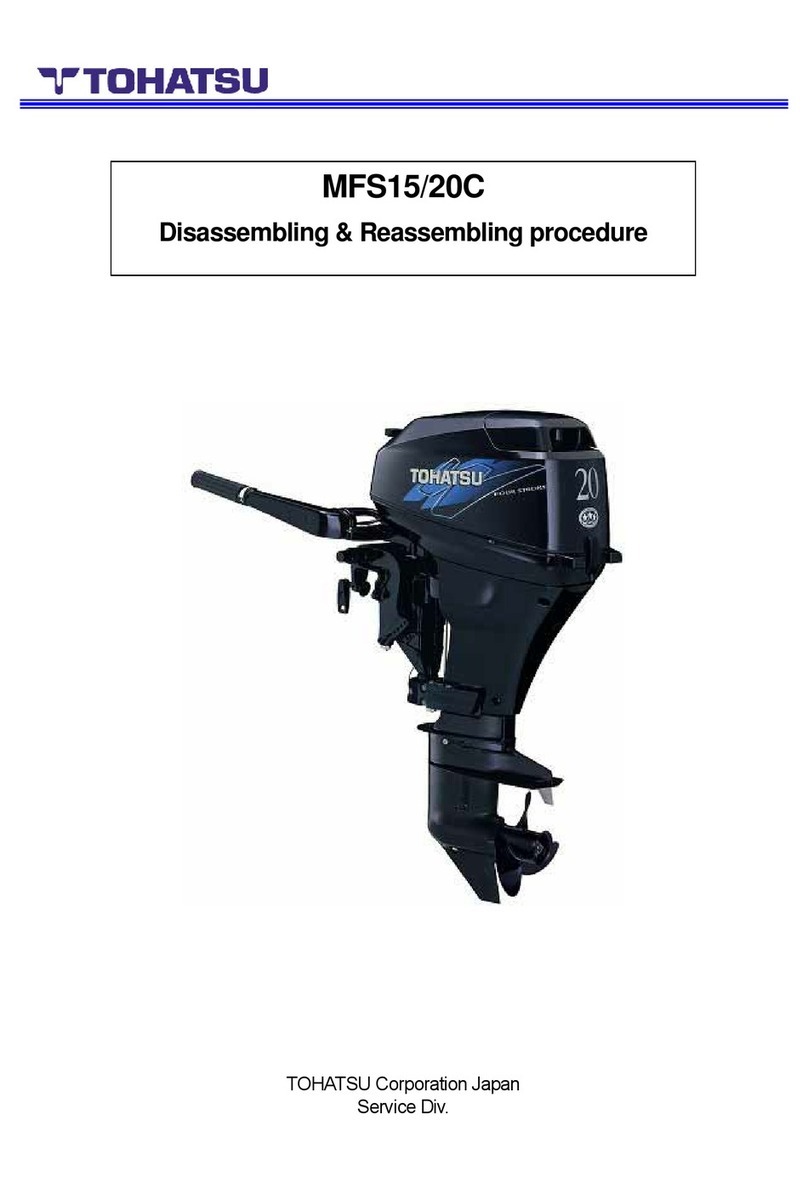
TOHATSU
TOHATSU MFS 15C Assembling/disassembling

Side-Power
Side-Power SE 130 IP Installation and user manual
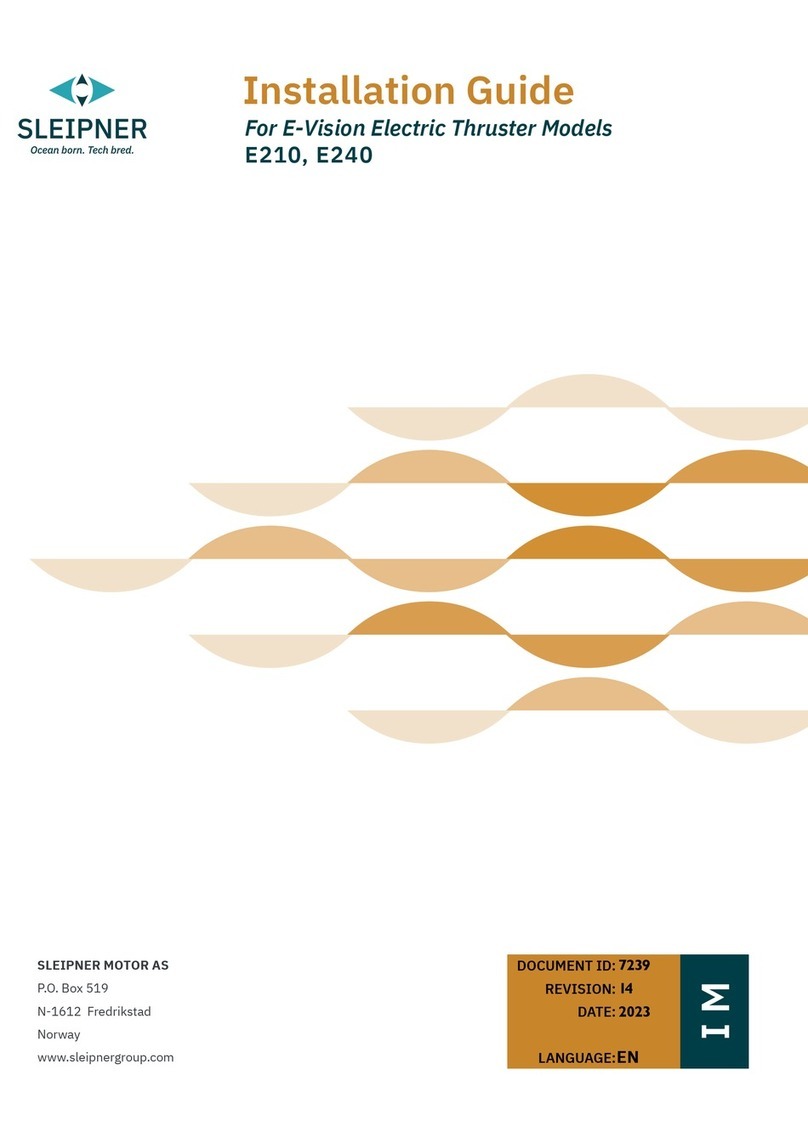
Sleipner
Sleipner E240/250TC-48V installation guide

Mercury
Mercury 125 OptiMax Operation and maintenance manual
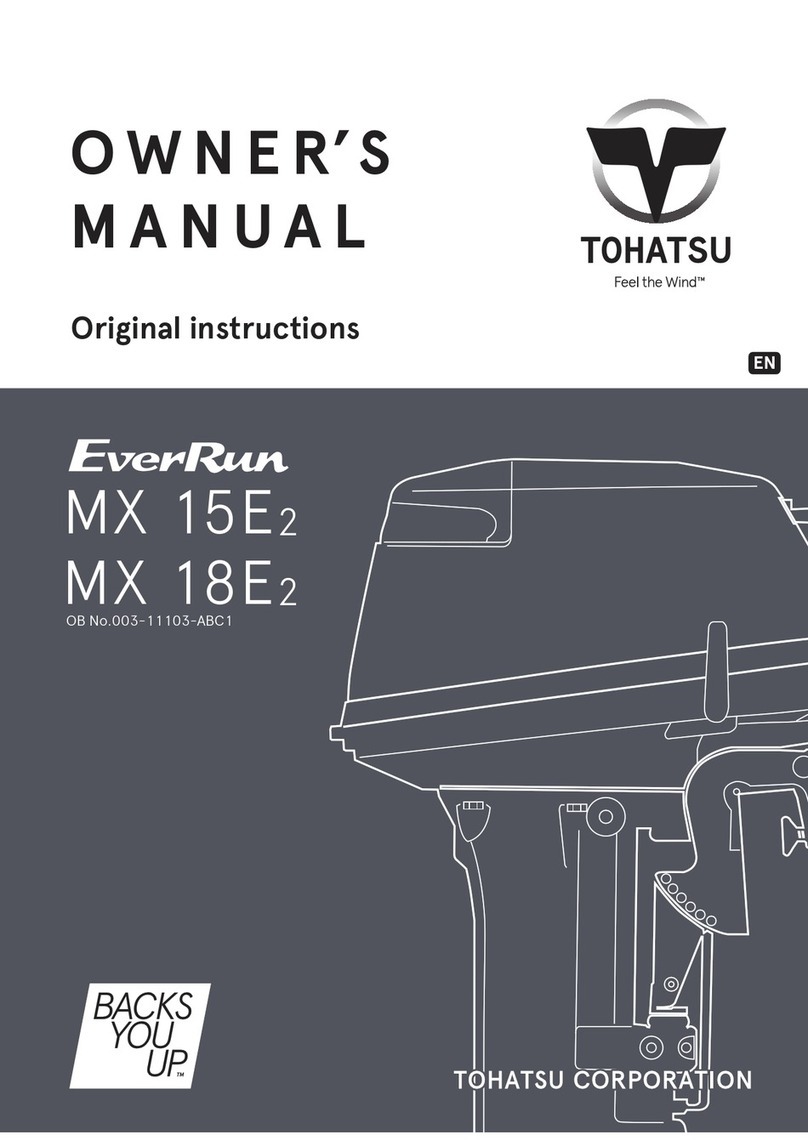
TOHATSU
TOHATSU EverRun MX 15E2 owner's manual
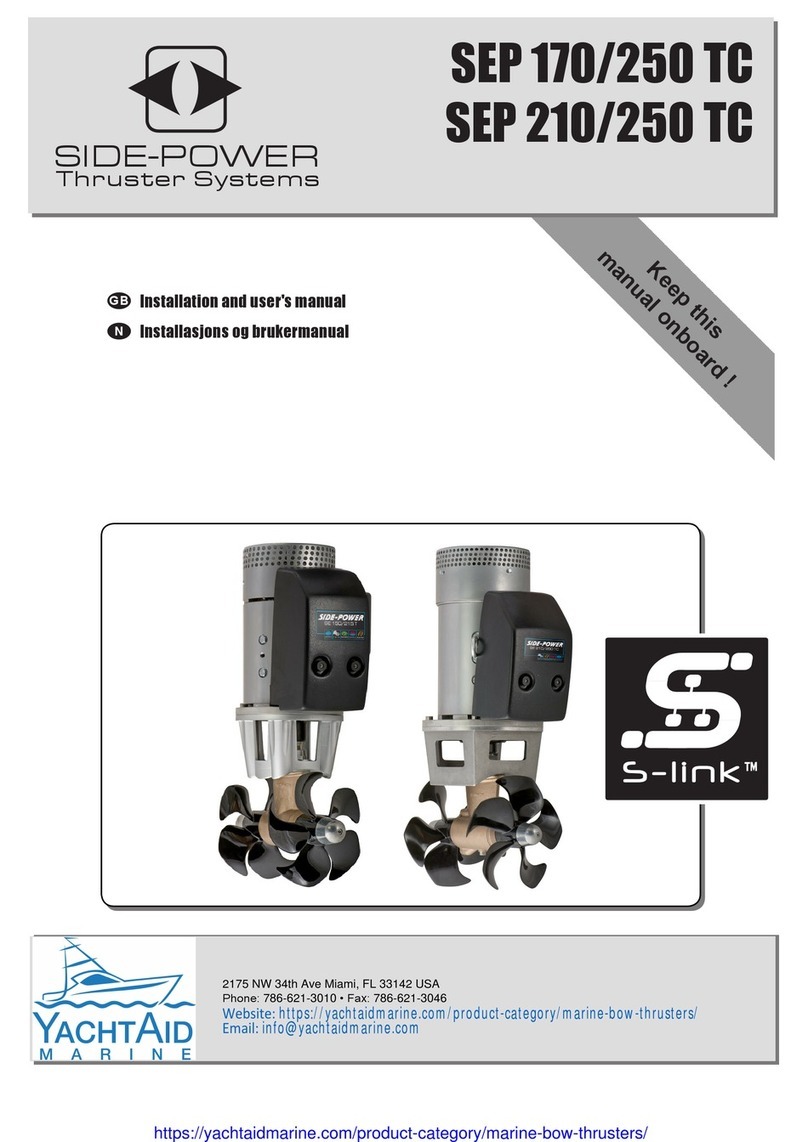
Side-Power
Side-Power SEP 170/250 TC Installation and user manual
